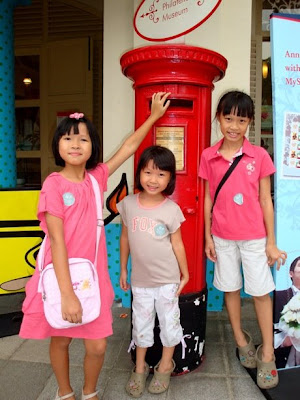Our first field trip for Singapore history was to Fort Canning Park last week. Originally known as Bukit Larangan (Forbidden Hill in Malay), it is believed to have been the site of an ancient palace. Sir Stamford Raffles built his home here and also used the site to experiment with crops. In 1859 the site was handed over to the military. The governor's residence was then demolished and a fort built on the hill which led to the name Fort Canning Hill.
Our first stop - Spice Garden. I doubt the botanic gardens that Raffles established on the site was anything like this. I suppose the Spice Garden is just a reminder of the work he did on the hill experimenting with crops. Here and there were little bowls containing spices you could touch and smell. I thought that was a nice touch although later at home I realised I have a whole lot of different spices stashed away, still in their packaging, which I had bought last year during a short period of time when I was determined to learn to cook.






















Brewing Chinese herbs

Sniffing pepper
Here we are at the Gothic Gates. The letters IHS above the gates stand for Iota Heta Sigm, the first three letters of the Greek word for Jesus.

A Christian cemetery once stood on the hill. It was cleared and some of the tombstones were set into the wall surrounding the open field. We walked along the wall and read the tombstones. Many of the dead were infants and young children with very few aged above 50.

Tombstone of W.H.Stephenson, Captain of Ship Santiago,
died Oct 31 1850 aged 41
And for one James Brooke Napier, a mere tombstone wouldn't do. His father, William Napier, had a memorial built for his infant son.

James Brooke Napier Memorial
A stone's throw away stands The Cupolas designed by architect George Coleman (I think his tombstone is also somewhere on the wall), the first Superintendent of Public Works, whose projects included Armenian Church and Parliament House.

The Cupolas by George Coleman
After all that walking, we stopped for a rest at Fort Canning Centre where there were excavated artefacts on display.

Then it was on to the highlight of Fort Canning Park - the Fort Gate and Wall. I told the girls Mummy and Daddy had some wedding pictures taken here at the gate. The girls were a little freaked by the dark passageway at first but once they got over it, they had fun going up to the roof of the gate and down.


Close to the Fort Gate and Wall is the OMSQ - Old Married Soldiers Quarters which I suppose was the residence of married soldiers and their wives. Next to it was a swing, old but still fun to sit on. As we sat on the swing enjoying the breeze and the beautiful surroundings, I thought what a nice place to live, but then again it probably gets really creepy at night.

After that, we went searching for the sally port. A sally port is a hidden door that leads in and out of a fort. There is only one sally port remaining at Fort Canning and I took quite a while to find it despite having a map in my hand (did I mention that I have a very poor sense of direction).
While looking for the sally port, we came across a Cannonball Tree. This is a South American tree introduced into Singapore some 70 years ago. It has big attractive flowers and fruits that looks like little cannonballs. It is not a common tree here so I was thrilled to find it.

Entering the sally port

"Hidden" door of the sally port

Cannonball Tree. Note the fruit in the centre of the photo.

Flowers of the Cannonball Tree
Near the sally port stands The Battle Box where General Percival made the decision to surrender to the Japanese.

The Battle Box
Then we made our way to where Raffles' house once stood. Along the way, we met a couple of 9 pound cannons and got bitten by more mosquitos (argh, forgot the insect repellent!). When we got there, we had a quick look at the lighthouse and the flagstaff. I wasn't very keen on these because they were just replicas and not the real thing. I thought the most interesting thing there was a tree with huge leaves.

One of a pair of cannons that was meant to shoot
9-pound cannon balls. Playing a decorative role rather
than a defensive one, the cannon was fired three times
a day at 5am, 1pm, and 9pm to announce the hour.
It was also fired as a salute and warning of town fires.

Replica of the original lighthouse

A couple of days before, I received our Family Season Pass to the museums so we visited a couple of museums that were in the same vicinity as Fort Canning Park - The Peranakan Museum before we went up the hill and Singapore Philatelic Museum after we came down. The girls especially love the Peranakan Museum because they give out this "Family Treasures" activity sheet which you bring around and get it embossed with Peranakan symbols and at the back page there is a illustration of a kamcheng that you can colour in yourself. What fun!



We had a great time that afternoon but I must be growing old because my legs were aching soooo bad that night. Nevertheless I'm looking forward to more of our heritage excursions.
No comments:
Post a Comment